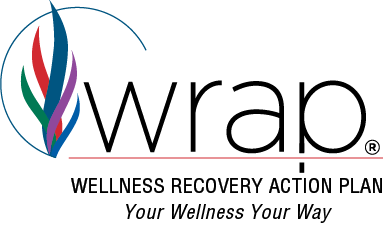Keynote address from the 1st International WRAP Around the World Conference 2011
Welcome Fellow WRAPers to this great celebration.
This is an absolutely incredible celebration of a remarkable achievement. When I was thinking about what to wear for this keynote, I went to a nearby town, Keene, NH, and to a store called Mirandah’s Verandah where they specialize in clothes for celebration. And that is where I got this jacket. I thought it was a perfect jacket for this celebration. So this is my celebration jacket.
We are celebrating that there are people gathered here from all over the world–Hong Kong, Australia, New Zealand, Scotland, Ireland, England, Canada, Japan, the Netherlands, and from over 40 of the United States. We are celebrating that WRAP has truly spread around the globe, and it continues to be spread each and every day. It continues to spread, even as all of us are gathered here for enrichment and renewal.
And we are celebrating, loudly, that we have done what we had been told over and over could not be done. They said no one could ever recover from what they call “mental illness”. But we have shown them that is not true. We have shown them that we can and do recover. We have shown them that we can and do go on to do the things we want to do with our lives and be the kind of people we want to be.
Dr. Gail Hornstein, a well-known mental health advocate who is working to develop a strong Hearing Voices Network in the United States like the one in Europe says:
We must remember that no matter how serious someone’s emotional difficulties have been, they can completely recovery. It’s crucial for them and their friends and family to know that. No expert knows enough about mental illness to say that you can’t improve. You might not know how to get better at this moment, but you have to start by knowing it’s possible.
We have not only recovered ourselves, but each of us, each of us, has reached out to others, bringing them along, to create a tremendous ground swell—a triumphant movement of wellness and recovery for all. All of us working together–we have done it.
I was at a conference in Santa Fe, New Mexico a number of years ago. An official from the federal Substance Abuse and Mental Health Services Administration took me aside and said. “What’s going on? We haven’t given you any money. We haven’t helped you in any way at all? Yet WRAP is everywhere. It’s spreading like wildfire”. I couldn’t give him an answer. All I knew was that, like you, most days I work from dawn until dusk, spreading the word about mental health recovery and WRAP. Often, like you, I am on the road, driving, riding on the train and even flying to do what I can do to make WRAP accessible to more and more people. I may slow down but I won’t stop. And I know you won’t either. In whatever way we can, we will join with the thousands and probably millions who are part of this “ginormous” effort. That is my six year old grandsons word.
My spouse Ed, who works relentlessly to make WRAP and mental health recovery possible for more and more people has, in his life, been involved in many social justice movements. He says that this human rights movement has had greater impact than any of the other great movements he has been involved in.
The WRAP and recovery movement, a movement of the people, by the people and for the people, affects all people, all sexes, and races, and cultures, all ethnic backgrounds, and sexual identities, and ages, and disabilities, rich and poor, people with lots of advantages and people with no advantages.
The United Nations World Health Organization Policy Analysis says: There is growing recognition within the international community that mental health is one of the most neglected yet essential development issues in achieving the Millennium Development Goals (you can find these on the internet). Mental health represents a critical indicator of human development, serves as a key determinant of well-being, quality of life, and hope, has an impact on a range of development outcomes, and is a basis for social stability. We are that important. And we are already accomplishing what they are trying to do.
Paulo Delvecchio, the Associate Director of SAMHSA’s Center for Mental Health Services said in his speech about my work at the 2009 Voice Awards presentation: We define mental health recovery as a journey – a journey of healing and transformation, a journey from the darkness to the light, a journey to take control of our problems – to take control of our lives, a journey for freedom – freedom both from mental health problems and freedom from the social exclusion that we experience.
Paolo likened this work to that of Harriette Tubman, who, like many of us, has traveled that journey and then went back to help lead countless others to do the same. And like Harriet Tubman, who had many other allies on the Underground Railroad, we have trained hundreds of others to, in turn, train thousands of others to spread WRAP and our message of recovery for all, across the nation and the world- effectively putting into practice the philosophy of “each one, teach one.”
As the song celebrating Harriette Tubman says, “come on up, I got a lifeline, come on up to this train of mine.” All these years later, it works for us as well.
As the conference committee was beginning to plan its work, Matthew contacted me and said they wanted to give out an award, and they wanted me to present it. And my immediate response was—no way. This is not possible. It would never be possible to figure out who deserves this award.
- Would it be Janet who has just smiled for the first time in 3 years?
- Would it be Paul who stepped outside his home for the first time in 10 years?
- Would it be Bonnie who has figured out that she can stop the incredible, searing burning pain and desire to die that she often feels by getting in the shower with her clothes on?
- Would it be Mark who has diabetes and has lost 150 lbs.?
- Would it be Carrie who just got the courage to attend her first WRAP meeting?
- Would it be Sally who has spent hours and hours listening to a friend who was the victim of violence?
- Would it be Jane who traveled with me to northern VT where WRAP was developed, who suggested we needed a planning process to address people’s need for a way to organize there wellness strategies and their lives?
- Would it be Erica who has worked with hundreds of people on the mental health recovery and WRAP correspondence course?
- Would it be Carol who helped with the WRAP research and spreads enthusiasm about WRAP and recovery wherever she goes?
- Would it be Walter who is working to integrate WRAP into the Veterans Administration system?
- Would it be Judith who secured the money and implemented the research that proved the evidence base?
- Would it be Matthew, Katie, Elaine, Copeland center staff who have at least quadrupled the outreach of the Copeland Center in the last year and a half and who organized this amazing conference?
- Would it be BJ who set up a business to use her talents to spread WRAP far and wide?
- Would it be Bill who developed the popular “Coping with Depression” video 20 years ago, and came back to Vermont this year to update it so it would be available for this conference?
- Would it be Liam who discovered WRAP from his therapist, used the book to start WRAP in his own life, and who now has joined forces with the Copeland Center to expand the network of WRAP Facilitators and workshops across Ireland?
- Would it be Rona who is now an advanced level facilitator, working to change the system in Scotland, Europe and even Ontario?
- Would it be Wenli who has expanded access to WRAP and Peer Support to the Asian people of New Zealand, brought WRAP to people who were struggling with gambling addictions and has a vision of bringing WRAP to her home country in China?
- Would it be Danielle who has worked tirelessly to translate the red WRAP book into French, insuring that the translation embodies the WRAP values and ethics?
Would it be Mike, a prison inmate in OK, who transcribed all of the WRAP and mental Health recovery Facilitator Manual into Braille, including all of the Powerpoint slides and the red WRAP book? - Would it be my mother who started the first peer support groups when she was institutionalized for 8 years in the late 1940’s and got herself discharged?
This list could go on and on and on and it would include each of you. Everyone one of you deserves an award. This is your celebration. Before we look to the future, let’s take a look at the road we have traveled together.
Almost 15 years ago, a small group of dedicated individuals came from all corners of Vermont–not people with advanced degrees to teach us what we should do, but people who were, even at that time, experiencing the worst of mental health challenges, people who were hearing voices, people who were so anxious it was hard to sit still for even a few minutes, people who were experiencing paranoia and delusions, people who had spent months and years in psychiatric hospitals, people who intimately knew the depths of despair, people who had been told they would never get well, that they would probably get worse as they aged.
These people came together in northern Vermont in the brutal winter of 1997 to learn various skills and strategies that they hoped might help them to recover and move on with their lives—RECOVER–a word not commonly used in those days for people with mental health issues.
At the end of 8 intensive days of presentation, discussion and activity, one brave woman, Jessie Parker, stood up and said, “This is all well and good, but I have been in psychiatric hospitals all across the country, and I wouldn’t have any idea how to organize what I have learned here into my life.”
So this group, in the cold of winter, came back to Bradford, VT, many of them over slippery country roads, even when it was storming—to spend several extra days together. On the first of these days, I was riding with Jane Winterling. She was driving her old Volvo. We had a 1 ½ hour trip on one of the two major highways in Vermont. Two other participants were traveling with us. On this particular day the highway was almost deserted. A cold wind was blowing and icy snow flakes were falling from the sky. Jane was talking about the need for a step-by-step process to address this issue, with various parts for things like Triggers and Early Warning Signs. About that time a big, empty flat bed trailer truck went barreling by us and its trailer, caught by the wind and the ice, swung around so close to the front of the car, that we all gasped in horror. WRAP almost ended right there before it began.
But we made it. The group quickly picked up on Jane’s suggestion and worked hard, checking out various options and having lengthy discussions, to develop what has now become known across the world as the Wellness Recovery Action Plan or WRAP.
I was so intrigued with what they had developed that I decided I would develop one of these plans for myself and use it in my own life. I spent an afternoon working on developing my wellness toolbox and the first four parts of the plan. My crisis plan came later. Right away I began using this plan as my daily guide to living. And I noticed an amazing exponential leap in my own wellness and recovery. Issues and circumstances that used to be big problems for me, I could now handle with ease.
I was so amazed that I decided to take a risk and share it with a larger audience at the International Conference of the Depressive and Manic Depressive Association. So it was with some trepidation that I shared the plan at the workshop I was leading.
The attendees had just come from workshops featuring brain section slides and chemical formulas. I was afraid I would be laughed out of the place. But, in fact, the opposite was true. The attendees were overwhelming enthusiastic. “Finally”, they said, “something we can do to help ourselves.”
That was the beginning. Since that time, WRAP has spread around the country and around the world. Sometimes it has been more like the little engine that could, “I think I can, I think I can, I think I can”. And other times it has spread with the speed and precision of that bullet train that Ed and I rode in Japan with Eri Kuno, from Tokyo to Sendi and from Nagoya to Kyoto. There have been local trains that spread the word from person to person and town to town. There have been trains that bumped along over rough territory. But always the movement has been forward.
Although I continue to do everything I can to keep the train moving and make it easy for people to hop on—setting up the Copeland Center so people can easily access the best there is, developing program models, curriculums and resources, training people to lead WRAP groups and training people to train people to lead WRAP groups—the train is now moving at lightning speed as it travels from Hong Kong, to Kurame, to Auckland and Whanganui and Christchurch, to England and Scotland and Ireland, from Honolulu to San Franciso, from Anchorage to Fort Worth and Palm Beach, Nashville, Asheville, Charlotte, Poughkeepsie, New Bedford-the list goes on and on and on.
Back in 2004, two British Psychiatrists, Glenn Roberts and Paul Wolfson, wrote an article for the journal Advances in Psychiatric Treatment called The Rediscovery of Recovery: Open to All. They said: In the burgeoning field of mental illness self-management models, WRAP is probably the most widely disseminated program of its type in the United States.
Now in 2011, we can easily say, WRAP is the most widely disseminated program of its type in the world.
As time went on there was more and more talk about evidence-based practices. Agencies and organizations were saying that they would only promote—only share—only pay for—mental health programs and initiatives that were evidence-based. Some people said that if WRAP was evidence based—meaning there were recognized research projects that proved WRAP’s effectiveness—WRAP would be co-opted by the health care providers and large managed care companies.
But most people agreed with me that we wanted WRAP to be available wherever people were going to get help with mental health challenges, and that we needed to develop that evidence-base for WRAP to be listed in the National Registry of Evidence Based Programs and Practices.
We started applying for research grants. But we were always turned down because instead of being from a major university or institution, we were people with a lived experience. We didn’t have the credibility to prove that WRAP works.
Finally a major researcher, Judith Cook at the University of Illinois at Chicago was able to get funded to do an intensive study of WRAP. Working closely with me and with Copeland Center trained facilitators, she studied WRAP across the state of Ohio and is now replicating the study in Illinois. We got the results we wanted. We proved WRAP works. And now we are listed in the National Registry of Evidence-Based Programs and Practices.
When my friend Moe Armstrong heard the news about our evidence-based practice listing he wrote, Maybe now these folks (meaning federal officials) will stop spending endless money trying to research and build programs which are not as good as WRAP. Maybe, they will put money forward to turn the research into practice using WRAP? Just some thoughts on a sunny afternoon. Thanks Moe
So now, with the work of the Copeland Center, Judith’s research and the evidence-based listing, WRAP can go on and on and on as it should, being a vehicle to wellness for more and more people over time.
Ed and I were in Japan doing a WRAP workshop for a small group of people who had been immersed in the mental health system for many years. One of the participants said, “I wish some one had told me 20 years ago there were things I could do to help myself.”
What keeps this train going? It is YOU. ALL OF YOU. You keep this train going and will keep it going into the future. You keep it going as you tell one person, and then another, and then another about WRAP. You keep it going as you attend, and as you lead WRAP groups. You keep it going as you integrate WRAP into mental health organizations and agencies.
You keep it going as you take WRAP into hospitals, into jails and prisons, into veteran’s facilities and onto the streets. You keep it going as you work with officials to integrate WRAP into your state, region, province, prefecture, county and country. You keep it going as you work to make WRAP available wherever it is needed, around the world.
And because of you, more and more and more people know the joy and wonder of recovery and wellness. Before I go on to describe the work of the future, I want to thank you, every one of you, whatever role you have played. Thank you, thank you so much from all of the people who have benefited from your dedication and your service.
We are all deeply committed to this work and will continue to do it as long as there are people who will benefit. WRAP is now a “given”. It has taken on a life of its own. But there is more work to be done. As Harriette Tubman said, “Every great dream begins with a dreamer. Always remember, you have within you the strength, the patience, and the passion to reach for the stars to change the world.”
We will all need this strength, patience and passion to accomplish what we must accomplish in the next 15 years. Let me explain.
As you know, as WRAP evolved, a set of clear values and ethics grew up around it. As these values and ethics began to emerge, we all shared them with lots and lots of people. Some people added to the list. Some people asked that particular points be amended in a way that made sense. Over time, more and more people seemed satisfied with the list.
And they were convinced that these Values and Ethics were absolutely essential if people were going to get the optimum benefit from WRAP.
Now I am deeply concerned about the future of these values and ethics, and about other issues related to mental health. You all know about the pendulum effect. At one side of the swing of the pendulum people are using the values and ethics and the train is moving forward nicely. At the other end of the pendulum, the values and ethics are ignored and violated, and the train is stopped. Even now we hear of this happening.
All of us, using our collective energy, the same energy that we have used and continue to use to spread WRAP, can, will and must keep the values and ethics strong and vital, keep the pendulum from swinging back to that time when recovery was not a word that was connected with mental health issues.
We will work as we have worked to spread WRAP to make sure that every person who reaches out for help with mental health challenges, whoever they might reach out to, is assured that there is hope, that lots and lots of people get well, stay well for long periods of time, and do the things they want to do with their lives.
We will work as we have worked to spread WRAP to make sure that every person who reaches out for help with mental health challenges is assisted and supported as they determine their own path, take personal responsibility for their own recovery, as they become empowered and as they learn to advocate for themselves. That they will be given the opportunity to discover their personal wellness tools and develop their own Wellness Recovery Action Plan.
We will work as we have worked to spread WRAP to make sure that every person who reaches out for assistance with mental health issues, whether they are in the United States or in Japan or in Ghana or in Hong Kong or in Timbuktoo will be treated with dignity, compassion, mutual respect, and unconditional high regard, as a unique and special human being who is fully accepted without prejudice due to diversity, ethnicity, language, religion, race, gender, age, disability, sexual identity, or “readiness” issues, and that they will treat others the same way that they expect to, and deserve be treated.
We will work as we have worked to spread WRAP to make sure that every person understands that there are “no limits” to recovery.
We will work as we have worked to spread WRAP to make sure that all mental health treatment and participation in all mental health programs, including the use of WRAP, is totally voluntary, that the person who is developing their WRAP decides if they want to do it, when they want to do it, how long they will take, what it will include and who will assist and support them as they work on it and live it.
We will work as we have worked to spread WRAP to make sure that everyone understands that the person who is reaching out for help or is developing their WRAP, is the primary expert on him or her self.
We will work as we have worked to spread WRAP to make sure that in all of mental health care and treatment, the focus will be on strengths and away from perceived deficits, the focus will be on things you do well, and negative judgments and deficit-based assessments are avoided.
We will work as we have worked to spread WRAP to make sure that clinical, medical and diagnostic language has been discarded, and is considered obsolete, without value.
We will work as we have worked to spread WRAP to make sure that people with lived experience work together and learn together to increase mutual understanding, knowledge and promote wellness, that peer support is the rule rather than the exception.
We will work as we have worked to spread WRAP to make sure that only personal wellness tools and other strategies that are simple and safe are used for treatment. Things like a broken cell phone. Ron Coleman in Great Britain tells the story of a man who had trouble going out in public because, when he did, his intrusive and horrific voices would start yelling at him, and he would yell back. Then someone would report him and he would get taken away to spend a few days at the local mental health facility. So he tried taking a broken cell phone with him. When the voices started up, he yelled back at them into the cell phone. And then nobody paid any attention.
We will work as we have worked to spread WRAP to make sure that difficult feelings and behaviors are understood as normal responses to traumatic circumstances, and to difficult things that are happening in our lives and that all treatment is trauma informed. We have come so far in this regard in the last 20 years. 20 years ago, all mental health problems were considered brain disorders. Now it is clearly understood that in many, many cases, mental health issues are a response to traumatic life experiences like abuse, poverty, neglect, war, disability and disaster.
We will work as we have worked to spread WRAP to make sure that restraints, seclusion, the use of body bags, tasers and other traumatic procedures have been eliminated. Congratulations to Pennsylvania and Delaware and others for the groundbreaking work they have done in this area.
And congratulations to the Copeland Center for developing a White Paper to address this issue and for beginning a new training initiative around this issue.
We will work as we have worked to spread WRAP to make sure that families like mine, and yours, will never again know the horror of losing a family member to long term illness, institutionalization or suicide.
We will work as we have worked to spread WRAP to make sure that people can reach out for help when times are difficult, that they will be offered simple safe solutions like wellness tools and WRAP, and that the stigma that accompanies reaching out for help in the hardest of times will be eliminated. We will open doors that used to be closed.
We will work as we have worked to spread WRAP to make sure that people in crisis have a place to go and be supported for as long as they need that support—a place where there is food if they want it, where they can be alone or with others, where they can be inside or outside, where there are things to do if they want to do something—whatever it is they need to do.
We will work as we have worked to spread WRAP to make sure that treatment meets the needs of individuals and not the pharmaceutical industry.
We will work as we have worked to spread WRAP so we may see the day when every person has a comfortable living space, food and easy access to health care.
This is big. Like me, you may wonder where you will get the strength, stamina, persistence and skills to accomplish an even greater task.
In order to do this we have to keep ourselves really “pumped up”, well-educated and up-to-date. How can we do this?
- We can do this at many different levels.
- We can do this by taking great care of ourselves, using WRAP, and being a model of wellness for others.
- We can share our story with others.
- We can listen to another person tell their story. We can listen and listen and listen.
- We can encourage someone as they uncover their wellness tools.
- We can support someone as they work on their WRAP.
- We can set up a WRAP group or work with someone to facilitate a WRAP group.
- We can go to a Copeland Center Training, or a lecture, or a seminar or a webinar.
- We can take on-line courses. We can do internet research. We can use the internet as an educational and an outreach tool.
- We can write educational articles for the newspaper and various newsletters.
- We can set up websites and contribute to existing websites.
- We can go to conferences, rallies and demonstrations.
- We can join and contribute to on-line and Facebook groups.
- We can offer WRAP to people with special needs like veterans, in jails and prisons, in institutions, and to people who are in homeless.
- We can reach out for technical assistance to the Copeland Center, to WRAP and Recovery Books or to one of the mental health recovery technical assistance centers around the country.
- We can reach out to people everywhere who need and want to know about mental health recovery and WRAP.
- We can give keynote addresses. If you are asked to give a keynote, I suggest you take a course on DVD’s (no tests) called “The Art of Public Speaking: Lessons from the Greatest Speeches in History”. With the help of this course, you can give a keynote address that will make a huge difference.
This list could go on and on and on. You did it. You did it with WRAP. You have kept the train rolling. I ask you now to undertake with me what will definitely be a much, much bigger task–taking the WRAP values and ethics, and the ethics that need to take us into the future to every corner of the world, to Bosnia, to Ghana, to the Congo, to Izbekistan, to Jerusalem, to Iraq, to Siberia, to Afghanistan, to Bolivia, to Mississipi, to Nevada, to Utah.
Look at how much we have gotten done in the last 15 years. I am looking forward to another great celebration, 15 years hence where we can say with certainty that the pendulum has swung so far that it can never again swing back. I look forward to seeing every one of you there.

Mary Ellen Copeland, PhD, developed Wellness Recovery Action Plan (WRAP) with a group of people with lived experience who were attending a mental health recovery workshop in 1997. She is the original author of the WRAP Red Book, as well as dozens of other WRAP books and materials. She has dedicated the last 30 years of her life to learning from people who have mental health issues; discovering the simple, safe, non-invasive ways they get well, stay well, and move forward in their lives; and then sharing what she has learned with others through keynote addresses, trainings, and the development of books, curriculums, and other resources. Now that she is retired, and that, as she intended, others are continuing to share what she has learned, she continues to learn from those who have mental health issues and those who support them. She is a frequent contributor to this site.





